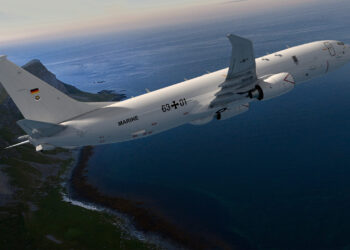Lockheed Martin,
Aegis Versatility Helps Avert Potential Disaster
KAUAI, Hawaii: Again demonstrating its adaptability to support new and more challenging mission needs, Lockheed Martin's Aegis Ballistic Missile Defense (BMD) Weapon System successfully destroyed an errant United States satellite, preventing it from an uncontrolled and unpredictable reentry and potential crash to Earth.
In the mission, the SPY-1B radar on the cruiser USS Lake Erie detected the satellite during its orbit and, through the capable equipment and computer programs comprising the Aegis Weapon System, computed a targeting solution to guide an SM-3 missile to intercept the satellite. Once the SM-3 was launched from the ship's MK 41 Vertical Launch System (VLS), Aegis guided the missile to the terminal phase of the intercept.
Lockheed Martin engineers recently worked with U.S. Navy, Missile Defense Agency, national laboratory and other industry engineers and scientists to modify the Aegis BMD Weapon System to specifically take on this one-time emergency mission.
With the co-location of the Navy's Combat Systems Engineering Development Site and Lockheed Martin in Moorestown, NJ, the work to design and test the modifications required for this mission was made much easier. The real-time collaboration between engineers and Sailors with the land-based Aegis BMD Weapon System was a critical factor in meeting the timeline for the mission.
“Aegis BMD and the team behind it have answered every call to defeat threats to our nation and allies,” said Fred Moosally, president of Lockheed Martin Maritime Systems & Sensors. “From the engineers designing and developing Aegis BMD to the men and women in uniform carrying out the mission, Aegis BMD delivers!”
“Through our Aegis BMD testing, we know that hitting a target in space is a tremendous challenge,” said Moosally. “With an unpredictable aerodynamic profile and significantly greater speed, this mission added new twists to that challenge … a challenge that was met head on with the Aegis 'build a little, test a little, learn a lot' engineering philosophy.”
Lockheed Martin engineers will now begin the process of reversing the modifications to USS Lake Erie and the two destroyers participating in the mission, USS Decatur and USS Russell, to return the Aegis systems to their normal BMD and multi-mission configuration.
The MDA and the U.S. Navy are jointly developing Aegis BMD as part of the United States' Ballistic Missile Defense System (BMDS). Currently, 10 U.S. Navy Aegis-equipped warships have the ability to conduct long range search and track and engage ballistic missiles. Another seven Aegis warships are equipped with Aegis BMD long range surveillance and track capability.
Ultimately 15 Aegis destroyers and three Aegis cruisers will be outfitted with the ability to engage short to intermediate range ballistic missile threats and support other BMDS engagements using the Aegis BMD Weapon System and the SM-3. Japan has purchased Aegis BMD capability for their Kongo-class Aegis destroyers.
The Aegis Weapon System is currently deployed on 85 ships around the globe with more than 20 additional ships planned or under contract. In addition to the U.S., Aegis is the maritime weapon system of choice for Japan, South Korea, Norway, Spain and Australia. Japan completed its first successful test of Aegis BMD in December 2007.
Capable of launching missiles for every threat in naval warfare, Lockheed Martin's MK 41 VLS, developed and manufactured at the company's Baltimore, MD, facility, has recorded a 99.97 percent launch success rate with more than 3,500 firings and is being used by 12 navies around the world. More than 11,000 MK 41 VLS missile cells have been delivered or are on order. MK 41 VLS cells are either in service or on order for 186 ships in 19 different ship classes around the world.
Lockheed Martin is a world leader in systems integration and the development of air and missile defense systems and technologies, including the first operational hit-to-kill missile defense system, Patriot Advanced Capability-3 (PAC-3). It also has considerable experience in interceptor systems, kill vehicles, battle management command, control and communications, precision pointing and tracking optics, as well as radar and other sensors that enable signal processing and data fusion. The company makes significant contributions to nearly all major U.S. Missile Defense Systems and participates in several global missile defense partnerships.
Headquartered in Bethesda, MD, Lockheed Martin employs more than 140,000 people worldwide and is principally engaged in the research, design, development, manufacture, integration and sustainment of advanced technology systems, products and services. The Corporation reported 2007 sales of $41.9 billion.









